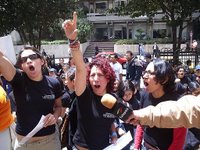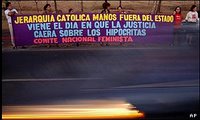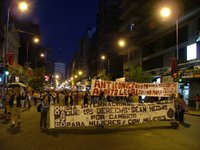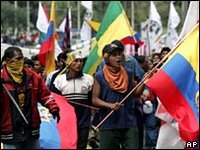 In mid-April, President Evo Morales of Bolivia, meet with the Presidents of Venezuela and of Cuba to sign the Bolivarian Alternative for the Americas (ALBA). This comes after two member countries of the Community of Andean Nations (CAN) signed trade agreements with the U.S. putting in jeopardy Bolivian crops that normally trade with Colombia and Peru.
In mid-April, President Evo Morales of Bolivia, meet with the Presidents of Venezuela and of Cuba to sign the Bolivarian Alternative for the Americas (ALBA). This comes after two member countries of the Community of Andean Nations (CAN) signed trade agreements with the U.S. putting in jeopardy Bolivian crops that normally trade with Colombia and Peru.
Some of the concrete decisions include Cuba’s promise to send Bolivia doctors to provide medical care to poor people and teachers to conduct a literacy campaign. Venezuela will send gasoline to the Andean nation and set up a $100 million fund for development programs and a $30 million fund for other social projects. In addition Bolivia will beef up the grouping's economic potential with the Andean nation's vast natural gas reserves. Cuba and Venezuela also agreed to buy all of Bolivia's soybeans, recently left without markets after Colombia signed a free trade pact with the United States.
With no Latin American nations signing the U.S.’s Free Trade Agreement of the Americas (FTAA) and only two (Colombia and Peru) signing individual smaller versions, ALBA is becoming more attractive and discussed by not just the heads of state, but the people in Latin America. One of the U.S. allies, Peru, is a potential ALBA member if nationalist Ollanta Humala prevails in a presidential runoff expected for May 28 or June 4. (For further on trade agreements read previous article.)
What is ALBA?
ALBA is a trade agreement calling on the nations of Central, South America and the Caribbean to join forces in solidarity and cooperation. One aspect is trade, but not necessarily in the capitalist conventional sense. For example, Venezuela sells Cuba 90,000 barrels of oil a day, and in return Cuba will pay a portion in cash but the rest with other goods. Their cooperation includes:
 Mission Barrio Adentro:There are presently 23,600 Cuban medical personnel in Venezuela treating 17 million people (there are additional Venezuelan doctors involved). They set up clinics in the most impoverished neighborhoods, as well as isolated areas, especially were Venezuelan indigenous people live, in the Amazon forest.
Mission Barrio Adentro:There are presently 23,600 Cuban medical personnel in Venezuela treating 17 million people (there are additional Venezuelan doctors involved). They set up clinics in the most impoverished neighborhoods, as well as isolated areas, especially were Venezuelan indigenous people live, in the Amazon forest.
Mission Robinson: This is a literacy campaign in Venezuela that after a two and a half year effort, on October 28, 2005, the United Nations Education, Science and Cultural Organization (UNESCO) proclaimed Venezuela “free of illiteracy”. Over 1.4 million people (76,000 were indigenous) learned to read and write (or relearn), with the help of Cuban resources and Venezuelan volunteers. It was announced that the literacy campaign would begin in Bolivia at the end of May with 20 Venezuelan, 48 Cubans and additional Bolivian volunteers.
Mission Milagros (Eye Surgery Program): Has carried out 220,500 eye operations recovering eyesight. Of that 188,389 were Venezuelan patients, 7,000 from Bolivia, 70 from Paraguay and the rest from Central American or Caribbean nations.
 Youth Graduate from Latin American School of Medicine: The first set of students graduated this year from this school just outside of Havana. There were 1,600 students from 27 developing nations plus the U.S. Students are given an 8-year education to become a medical doctor for free (including food and board). The youth must come from an impoverished background and special opportunities to those from indigenous decent. Since then, the program has expanded to enroll 10,500 students from Latin America, the Caribbean, North America (65 U.S. students) and Africa; the total number of foreign medical students in Cuba is now nearly 12,000 from 83 countries. President Hugo Chavez also announced that another school would be constructed in Venezuela with the same purpose that will triple the amount of students.
Youth Graduate from Latin American School of Medicine: The first set of students graduated this year from this school just outside of Havana. There were 1,600 students from 27 developing nations plus the U.S. Students are given an 8-year education to become a medical doctor for free (including food and board). The youth must come from an impoverished background and special opportunities to those from indigenous decent. Since then, the program has expanded to enroll 10,500 students from Latin America, the Caribbean, North America (65 U.S. students) and Africa; the total number of foreign medical students in Cuba is now nearly 12,000 from 83 countries. President Hugo Chavez also announced that another school would be constructed in Venezuela with the same purpose that will triple the amount of students.
As cooperation between these nations continues, there will be further examples, and hopefully we will see other countries in the Americas joining in.
 On May 10, thousands of indigenous Ecuadorians (from the Amazon area), along with workers and sudents, marched in Quito demanding the Ecuadorian government take over Occidental (Oxy) oil facilities and they had 15 days to do so before nationwide protests would begin. During the month of March, the entire Ecuadorian nation was shaken up with massive demonstrations by labor, student and indigenous organizations. On May 16, the Ecuadorian government announced the take over of the Oxy oil facilities. Oxy is the country’s biggest foreign investor said they plan sue the government. In response, the U.S. government announced it is breaking off trade negotiations with Ecuador.
On May 10, thousands of indigenous Ecuadorians (from the Amazon area), along with workers and sudents, marched in Quito demanding the Ecuadorian government take over Occidental (Oxy) oil facilities and they had 15 days to do so before nationwide protests would begin. During the month of March, the entire Ecuadorian nation was shaken up with massive demonstrations by labor, student and indigenous organizations. On May 16, the Ecuadorian government announced the take over of the Oxy oil facilities. Oxy is the country’s biggest foreign investor said they plan sue the government. In response, the U.S. government announced it is breaking off trade negotiations with Ecuador.


















